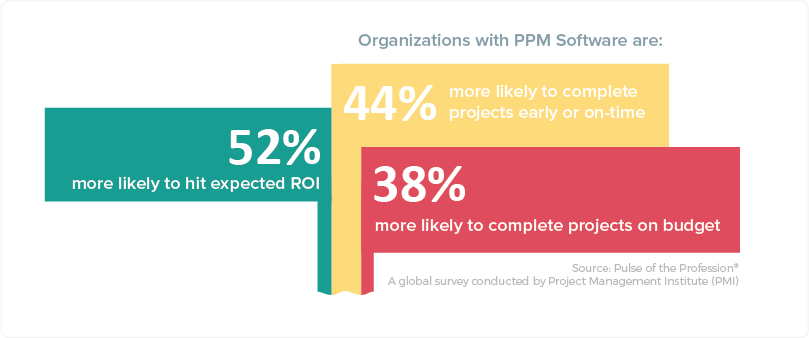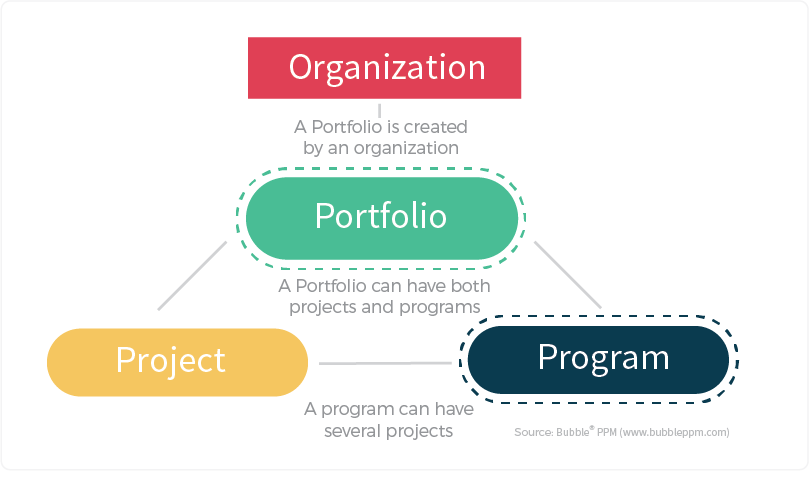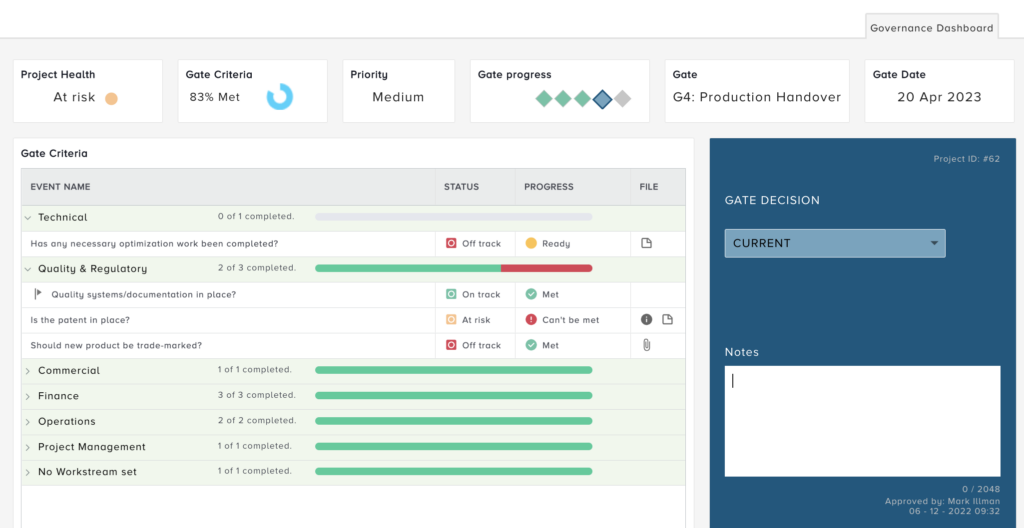
Why connecting Project and Portfolio management will deliver greater ROI to your organization.
Consider these project and portfolio management challenges: How do we prioritize which projects to take forward and how can we deliver the selected projects efficiently and reliably? In this article, we focus on bridging the chasm that can grow between portfolio-oriented company leaders and the detail-focused project delivery teams on the ground. We will explore the nature of these issues, what can be done to overcome differences, and how specialist software is empowering organizations to take a more collaborative approach to Project and Portfolio Management. For readers on the journey to vendor selection, we explore three platform traits to look for when considering a PPM software solution for your organization.
In any complex business, there will likely be friction between strategically-focused business leaders and the more operationally-focused project delivery teams. But both groups are critical for the organization’s success.
There are often common themes that contribute to this friction, such as:
- Balancing short term vs long term priorities,
- Interpretation of the ‘facts’ used to inform decisions,
- Singular focus on successful delivery vs ensuring big-picture strategy alignment.
In these cases, we see time and again the value that the latest generation of Project and Portfolio Management platforms can bring, helping to bridge the internal differences between teams and decision leaders, allowing companies to react quickly to external change, and breaking down siloed decision-making.
One source of truth
In general terms, everyone in an organization has the same goals of growth and success. But while both the C-Suite and project delivery teams usually share the same top level goals, they don’t always share perspectives. With finite resources, the organization often needs to pivot and adapt, either to external factors or because of strategic changes. But without unified project and portfolio strategies, those shared visions of success will be hard to achieve.
PPM software allows organizations to connect and distribute real-time information to all stakeholders in context-sensitive ways. The growth in this software sector (around 14%, YoY) can be attributed to the value companies recognize in its ability to align project, program, and portfolio data sets (often by unifying disparate data sources throughout the enterprise) while, at the same time, presenting role-relevant, reliable information to different audiences.
A holistic view
It is often difficult for individual project managers to see their individual work in the context of the wider picture. With a PPM system, through the course of regular work, relevant data is captured and easily aggregated into a holistic view.
Senior leaders need visibility across all their portfolios and projects. With the 10,000-foot view, their decision-making at the macro level is more effective and can be better aligned to business strategy. Rather than getting mired in the detail of individual projects, managers can use collated information to anticipate risk or change and react accordingly.
Legacy project management solutions tended to separate the macro view and the micro-focused project details. In the latest generation of PPM software tools, the holistic view is crucial to its ability to add value to an organization. And because all stakeholders, however minor, are viewing relevant slices of the same data set, they can be assured that the decisions they make are both fact-based based and drawn from a shared understanding of the whole.
Selecting a PPM software vendor
For those on the journey to selecting a PPM software vendor, we believe there are three crucial traits that any PPM platform needs to exhibit.
1: A focus on tailored visualizations
Successful PPM platforms provide value from both the top-down and the bottom-up. This means that the tools, data, and modules within need to be flexible enough to suit each of your different stakeholder groups (ideally through a role-relevant set of permissions/views).
Project managers and individual team members are typically focused on areas that need urgent attention, and by drilling down into the detail, they should be able to easily identify the information needed to fuel the important conversations to get work back on track.
Managers, on the other hand, need a “rolled up” view of all the mission-critical challenges facing their teams to address any underlying problems that may be affecting multiple projects.
A good PPM solution will be able to provide views and the underlying data to drive the right conversations at multiple levels of the organization.
2. Automation and consistency
Repeatable processes offer opportunities for automation, especially when multiple projects benefit from adherence to consistent delivery. Replicating successful project structures and cadence can help teams build on success, fine-tune what works for even better results, and incorporate the principles of continuous process improvement. Ultimately this drives more reliable and higher quality delivery.
PPM software can also be leveraged to track ongoing process metrics, such as percentage of on-time deliveries or average lead time (or time-to-market). As one of the mainstays of PPM software, your solution of choice should provide instant answers through data dashboards and automated collection of this data.
3. Strong governance
At a higher organizational level, decision-makers are more focused on answering the ‘big questions’ and key deliverables than on the detail of completed tasks. Whether you’re releasing the next tranche of investment or quality-assuring a key milestone, a good PPM solution will right-size the information collected between your delivery stages and decision gates.
Senior leaders don’t need to know the detail of all the completed tasks; they just need re-assurance that the current business requirements have been met to progress the project. A robust structure for assessing readiness to progress, in both business and delivery terms, should be a pre-requisite. Remember, project execution is both a delivery and a cessation mechanism (e.g., doing the right projects, and doing projects right)!
Therefore, it is important for any PPM solution to present a relevant set of information around delivery stages and decision gates. The presentation of this information should be integrated in in-built governance processes that reflect the key checkpoints for projects within your organization.
Conclusion: your takeaways
Defining the ROI of an investment in PPM software depends on both your starting point, and the organizational challenge areas you wish to improve. There are no hard and fast metrics that apply to specific PPM vendors, company types, or business sectors. PPM is an investment in both time and money. However, the dividends will always far exceed the investment. Most PPM solution providers charge a fee to deploy the platform (e.g., to configure their platform to your organizational needs) as well as a monthly user license fee. There can be significant variance in these, but a base starting point is often to consider your 1st year investment as equivalent to what you’d spend on hiring an experienced Project Manager. If in doubt, consider the 3V’s of PPM software selection:
- Validation: A good PPM solution will empower your project delivery teams while seamlessly informing the wider business. But it’s important to spend some time upfront gathering requirements and deciding upon your ‘must have’ and your ‘nice-to-have’ functionality.
- Value: The ultimate value that a solution brings depends on what your organization wants to track and improve. Return-on-investment (ROI) should therefore be seen from both a “soft” and “hard” ROI perspective. Ensure that the goal of a deployment has tangible metrics that you want to see improved.
- Vendors: Identifying a PPM platform that’s right for your organization should facilitate a continuous growth in organizational productivity. If you’ve already established the need for a more joined-up approach to Project and Portfolio Management (or are considering a switch from a project to a PPM software) it’s important to match the offerings of the various vendors to the unique needs of your organization and industry vertical.
As with all software, there’s a range of solutions in the market, so your ultimate decision will likely be based on which provides the best requirements to functionality fit. Consider what level of effort different solution partners will go to right-size the initial deployment towards some ‘quick wins’ for you and your organization; what importance they place on working with you when new needs become apparent, and what potential there is for hidden charges if key elements of software/service are not covered in the initial deployment/license fees.
If you have tangible goals upfront, then you can ensure that your vendor selection process is aligned with those goals, and that your ultimate solution partner will help you achieve the objectives over time.
To illustrate this article, we’ve benefited from insights and images provided to us by the team responsible for the Bubble® PPM Software platform. You can visit the Bubble® PPM website or click on the following links to learn more:











